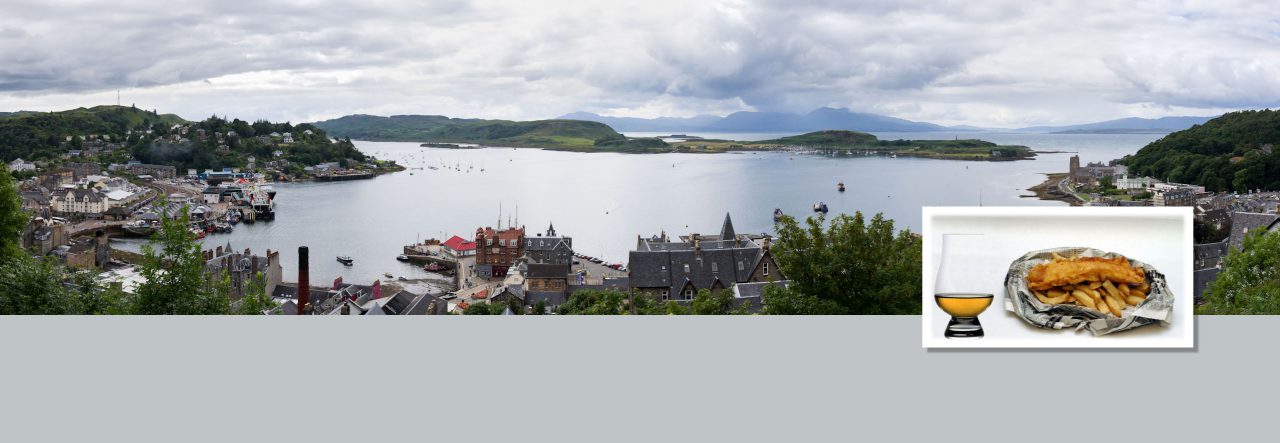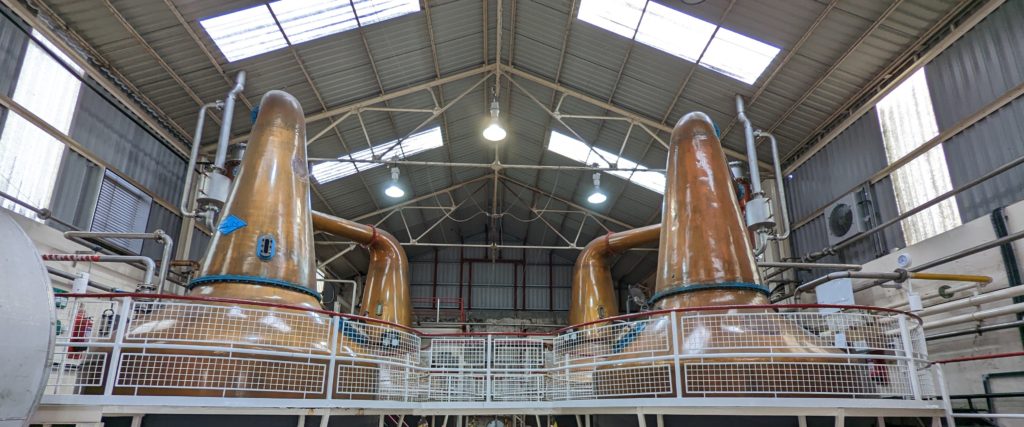In which I take a wrong turn, traffic is too slow, we delay a tour for the better at one of the oldest distilleries in Scotland, and induce whiplash through an incredible experience at literally the newest distillery in Scotland…
We woke up early, loaded the car, then stopped back in to Failte for a full Scottish breakfast. Today’s a two-distillery day, so we need the protein. Hey, it’s an excuse that’s served me well for years, so I’m not about to change it now.
We had about an 80 minute drive to our first destination, the Ben Nevis distillery in Fort William at 10:00am. We were a tad later than planned in departing, pretty much right on the T(our)-80 minute mark, but I thought I might be able to make up a few minutes en route. Yes, I know, it’s like I’d never driven in Scotland in the Highlands in commuter hours before. And then there was the wrong turn before we even left Oban that dumped us in the city center and cost us about 5 minutes. For the record, when the in-car SatNav/GPS announces “Keep Right” it should not mean “Turn right onto this entirely different road that has nothing to do with the right-hand option of the road you’re currently on.” (I have issues with the verbal directions this SatNav system is programmed with). Gits.
And then there was the lorry. Actually, I have no problem with the lorry. It’s a lorry, and the roads are tight and windy (that’s windy as in they turn back and forth, not windy as in they blow us back and forth). My grandpa test drove lorries professionally, so I know what they are and aren’t capable of on these roads (’cause he told me). My problem was the car /behind/ the lorry, the one that was quite content to drive at 2/3 the speed limit for 20 miles rather than pass the lorry. That meant there wasn’t enough space for any of the 10 cars behind to pass either, so 35-40mph it was on this 60mph road for, well, long enough that there was no way we were going to make that 10:00am tour. The lorry and car did turn off, eventually… about 200m from the distillery gate. Gits.
Talking of gates… Ben Nevis is one of only two distilleries that I’ve visited that has a guard and a gate (the other was Auchentoshan). It makes sense, because the Ben Nevis distillery is right in the middle of Fort William, so there’s a lot of drive-by traffic. I mean that in the sense of passer-by, just in the neighbourhood, “oh look a distillery we should visit” sort of thing. I don’t mean it in the passing gang members, looking for a target, unloading clips into the distillery sort of thing. Besides, it’s Scotland, they’d be knives. Not expecting the gate, I almost ran over the wee security guy, mostly because I was right behind a lorry that had been let through and I was just following along. Wee security guy didn’t seem too perturbed, and helpfully directed us to the car park I was clearly headed for anyway, and told us to check in with the front desk that we were about to check in with, in order to determine if we’d be allowed to take the tour we’d already called ahead to reschedule. Helpful chap.
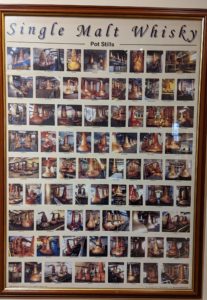
And so we arrived at the visitor center about 10 mins after the tour started. The nice folks at the front desk (who took a few mins to warm up, but that seemed mostly due to an unfortunate Trip Adviser review they were trying to get to the bottom of) offered us the option of joining the 10:00am late (SO glad we didn’t) or rebooking on the 11:00am tour. Today we have much time between visits, so 11:00am works just great.
We had a coffee, and chatted a bit with Ennis (who would be our tour guide) who’d spotted the Souls logo on our shirts. I also spotted a poster the likes of which I’ve been after for years. It was a poster of the stills at about 80 different distilleries around Scotland. Consider previous posts of mine and my thing for still shapes and designs. I almost stole the bloody thing. But I was good, and just noted the website that was in the corner of the poster… nope, that don’t exist any more. But I can get the poster, on a whisky auction site, for about 60 quid. Yeah, maybe, some day.
The tour started, and two things became clear. First, Ennis was a phenomenal tour guide. One of the few men we’ve had lead us through a distillery, interestingly enough. His script was comfortable and flawless in a way that’s only possible if you really know the facts. Not as tight or deeply knowledgeable as Kilchoman-Emma, but definitely on that trajectory. The second thing that became clear was that we were very happy we hadn’t missed the first 10 minutes of the tour, which was a wonderfully encapsulated history of the distillery.
Ben Nevis distillery was founded in 1825 by “Long John” MacDonald, so called because he was huge, especially for the early 1800’s: 6 foot 6 inches tall, and eccentric as all hell. Folks loved him. He chose the site because it was at the base of a stream the source of which is a wee corrie toward the top of Ben Nevis. Water ran from there, through the soil to the granite rock, then down the north face of the Ben. They believe that Ben Nevis translates to “Mountain with it’s head in the clouds” because, well, there are about 29 days a year when there is any kind of view from the top. Lots of cloud and rain, great for a distillery’s water source.
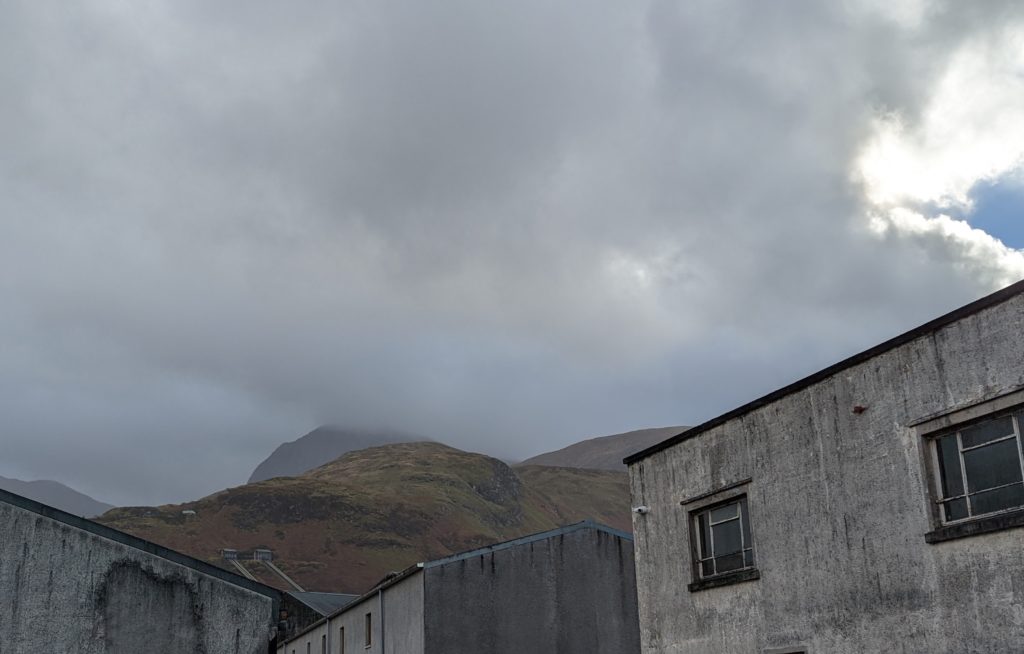
Long John was a savvy marketer, and played his eccentricities for free marketing. Any story was a good story. And some stories were really good stories. For example, when the Duchess of somewhere visited and decided to have a wee climb up the Ben and promptly got lost in the clouds. Long John realised she’d been gone too long, rode on up the Ben to find her, found her, and brought her safely back to town. It’s said that he was such a gentleman, that he even made her a cushion for the saddle out of his own kilt… one wonders about his own subsequent attire. Then there was the time that Queen Victoria visited, which pretty much sealed the distillery’s fame. Ben Nevis whisky became popular all across Europe, and was even the dram of choice of the Dutch royalty.
Whisky’s popularity soared in the late 1800’s when the wine industry took a hit. (I may have a few date ranges wrong here, but I think they’re about right). A particular pest arrived in Europe which decimated the wine harvest, affecting wines, sherries, etc. and folks turned to whisky as their new booze of choice. In the 1880’s, Ben Nevis sold about a million litres. By the 1890’s, it was the biggest whisky producer in the world. But, the early 1900’s took their toll: the depression, prohibition in the US, etc. etc. I believe it closed for a bit in the late 30’s early 40’s (something about a war or some such), and was sold to a Canadian in the late 40’s.
In keeping with the tradition of eccentric owners, this Canadian had fled Canada to avoid the massive amount of debt he was in. Which meant he arrived with nothing, but didn’t let that stop him. He made some money by somehow buying small businesses, and eventually bought the distillery. Things were great until the mid-70’s when whisky as a whole took a hit, and it closed again in about 1978. There were a lot of distilleries that closed about this time: interest in whisky took a nose-dive, and the spirit wasn’t selling. Talk of the “whisky loch” abound – all the whisky sitting in casks in closed or soon-to-be-closed distilleries. But then things picked up again. Nikka bought the place in 1989 (there’s a STRONG connection between Scotch whisky and Japanese whisky, which I’ll let someone else write about). And, well, here we are now.
|
The Ben Nevis process is pretty standard, with a few quirks that make their spirit theirs. Malting is standard: 2 days steeping, 5 days germination, 2 days to dry. Their batch of 9 tons of malt produces 4,000l of spirit, and they crank through about 150 tons of barley per week. The do do some peated malt, but most is not. They’re trying to recreate the original Ben Nevis character – which would have been peated – based on an analysis of samples from the 4 bottles remaining from that time. Which is kindof fun and amazing stuff. Ennis did a nice job highlighting the four stages of whisky making: germination, fermentation, distillation, and maturation. Well, he did mention the fifth stage: consumption. He played the dad jokes well throughout the tour. In the mill room, I noted the Porteus mill, but was amazed when I heard it was built in 1975. Amazed a) because I’ve never seen one that young; and b) because I had no idea Porteus had lasted that long. I also learned that second hand Porteus mills, which is how almost all new distilleries get them, costs you about £100,000 at auction. So that’s nice. The mashing process takes about 9 hours: 38,000l at 68C, 19,000l at 74C, and 20,000l at 82C. About 42,000l is sent off to the washback. The washback room was entertaining as two of the eight washbacks were Oregon Pine, the rest were steel. Apparently they tried the two wooden ones, decided that the difference in their particular spirit was negligible, so stayed with steel for the rest because they’re far easier to clean. They keep the wooden washbacks because they look pretty. For real. Interesting to note, of all the washback rooms I’ve been in, this was the most potent. There was a particular build-up of the odors and escaped CO2, which Ennis commented on as there were kids in our group and he wanted to offer them the option of a hasty exist, which they promptly took. They historically used brewers yeast, but switched to Mauri distillers’ yeast for reasons; however they want to move back to recapture that original fermentation, but apparently brewers yeast is hard to come by at the moment. Their fermentation period is only 48 hours, because they’re looking for lighter sweeter notes (versus more complex fruity notes that come from longer fermentations). Fun fact: the gases that are expelled from fermentation are called “barm” and gather at the bottom of the wash room. Distillery workers who had to spend time down there would go a little loopy due to the gases (for as long as they were in the room), so there’s a theory that this is where the term “barmy” comes from. Seems legit.
The still room was next, and as always, it didn’t disappoint. 2 wash stills, 2 spirit stills. They sell the pot ale from the wash still as fertilizer, which is considered a particularly good fertilizer as “the grass grows half cut” ba-dum-tss. Their heart cut is kinda huge at 75-60%, and gets them about 4,000l at approx. 70% abv. Each distillation takes about 8 hours for a total of a 16 hour run. The stills, however, were super interesting. Well, to me at least. Shut up. The neck on the wash stills was the fattest I’ve ever seen. Seriously, I could fit in them easily. I mean, sure, I’d suffocate and boil to death, but I’d fit. The copper contact must be sooo low in there. Related fun fact, one of their stills has been in place since the early 70’s. Turns out stills last a long time if you close the distillery for a decade or so… We looked at the casks, which was all pretty standard. But I did learn that the requirement to age for 3 years and 1 day to legally be considered Scotch whisky was thanks to the 1915 Prime Minister David Lloyd George, who was trying to reduce – well, slow down – alcohol production in the UK. This resulted in a far better product which instantly became more popular so, yeah, thanks PM! We also also learned that distilleries play nice with each other, and sometimes exchange casks. John noticed a few Edradour casks sitting around, so we asked Ennis if there was a relationship between the distilleries. Well, partnership. We presume the distilleries aren’t sneaking out at night for some, um, illicit distillation? And, no, no formal partnership. They just talk, and occasionally trade things like casks e.g. Edradour had used these casks once and weren’t going to use them again, Ben Nevis had an interest in playing with this particular type of cask, so they got ’em. It makes me happy that, for all there has to be some level of competition between distilleries, it doesn’t necessarily get stupid and they get along well enough to work with each other in this kind of way. We heard something similar at another distillery, on Islay I believe. The distillery staff made the comment “Aye, we all get along and help each other oot. The big boys at the owner company probably wouldnae like it, so we just dinna tell them.” And then it was off to the tasting. Four drams, which John and I took in driver’s dram form as things had run a little late and we wanted to hit the road and not be late a second time in one day.
|
Our next appointment was 70 miles away, down some gorgeous, near-empty wooded and loch side stretches of road, as well as a rather exciting stretch of single-track road which brought only two close encounters of the type that make driving single-track roads so much fun. And I’m odd in this regard because I don’t mean that ironically. I find driving such roads a ton of fun. Not everyone else does. Like my passengers.
We were headed to Speyside, at the edge of the Cairngorm mountains, and the aptly and not-coincidentally named Cairn distillery. This place opened for tours about 3 weeks ago, so we are literally among the first to visit it. I’d come across their website while looking for info on Benromach (same owning company, but more about that in a minute). It indicated that they’d be opening in autumn 2022 and, well, we were going to be there in autumn. So I sent them an email asking if we could peek in since we’d be driving right past their front door. No response. Then John noticed that they had upped their social media presence and, suddenly, were offering tours. So we grabbed a tour. The Adventurer Tour, which ended with 3 drams instead of the standard 2, and a few munchies to boot. Sold!

The Cairn is owned by Gordon & MacPhail, and it’s fair to say that we wouldn’t be on this trip, likely wouldn’t have this hobby, almost certainly have a lot more money in our bank accounts, and may not ever have tried single malt Scotch whisky if it weren’t for G&M. They’re credited with having really introduced single malt whisky to the world in a big way, and launched its popularity. You see, back in the day, people were drinking blended Scotch. They still are. Millions of liters of it: 85% of all the Scotch sold and consumed in the world today are blends. They’re generally lighter, less complex, easier to drink, easier to blend or mix, and have a wider audience. Single malts are stronger, more robust, complex, and idiosyncratic. I mean, they highlight one specific spirit and nothing else. Who the hell wants to drink that?
Well, for a long time, G&M were interested in maturing spirits from distilleries in their own casks, and in 1968 launched the Connoisseur’s Choice selection of single malts, and it was a huge success. The man behind this project was George Urquhart, son of John Urquhart, who had partnered with the original James Gordon and Alexander MacPhail back in the early 1900’s when their whisky ventures began. John selected and purchased mature local whiskies, realized the influence that casks had on the spirit, and decided to take on that part himself, becoming a master of maturation. His son, George, carried on this tradition and leaned in to a long term philosophy of long term maturation, with a particular focus on sherry casks. Fast forward to 1968 and, well, yeah, George Urquhart is considered by many to be the father of Single Malt whisky.
Now, for all their success as an independent bottler, G&M didn’t own their own distillery until they purchased the mothballed Benromach distillery back in 1993, opened by then Prince Charles in 1998. I’m a huge fan of Benromach, and visited them back in 2017. Great visit, great whisky, I thought they were sorted. Nope.
The Cairn distillery is brand spanking new, built from the ground up, with very specific designs in mind, a determination to both fit in and improve the local environment and habitat, and a long term plan that they are not at all shy about placing front and center in their visitor center.
The distillery is in no way shape or form the shape or form of a traditional distillery. It’s a fantastic marriage of form and function, proving that you can do both and more. The focus on the local environment is impressive, and they insisted on getting buy-in from local residents, farmers, etc. before they even started building. In addition to the distillery itself, they’re building on the environment. They’ve created a habitat and refuge (right down to nesting sites) for the endangered Goldeneye Duck, which has already seen an 8% increase in population just in this area. They’re creating wetlands for other species that I don’t recall. They’re also planting specific trees, with a view to increasing local woodland and providing habitat for more local species.
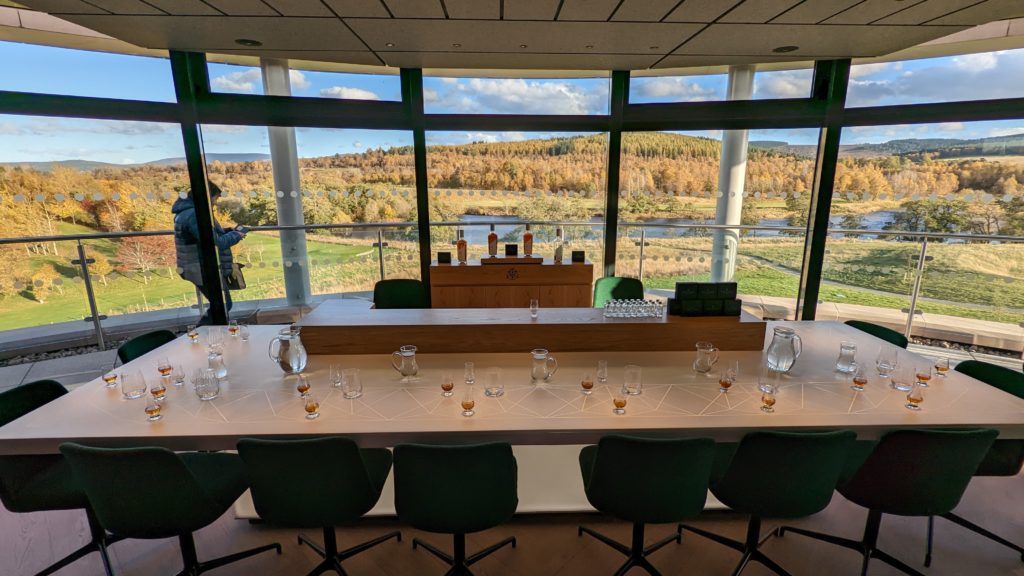
From an operational point of view, water is drawn through bore holes with reach down 30m to the aquafer, which replenishes regularly from nearby hills, rainfall, etc. This water is naturally filtered, so no need for the distillery to include a purification plant. Barley is sourced from maltsters in nearby Inverness, as is their yeast. And they don’t age on site specifically because warehouses would have increased their footprint many times over and they didn’t want to do that. The distillery is clearly visible from the road, but locals and neighbors (a couple of whom were on our tour) have commented that it blends in nicely from most other angles; the work they’re doing on the surrounding habitat will only increase that blending in. Aging is done at the Benromach location – which has a lot of warehouse space – as well as locations near Elgin and Edinburgh. The decision to drive tankers full of spirit in lorries was a deliberate choice to avoid the local impact noted above. They’re also looking for other ways to offset, and hoping that they can adopt electric lorries as soon as such an option becomes viable.
By the way, the name and logo was chosen in some ways to reflect the local environment: Cairn-gorm mountains; cairns, which are built on mountains to guide the way; that sort of thing. It was also chosen for its simplicity: they want this to be a global brand, so they wanted it pronounceable in as many global dialects as possible. Neat idea.
I’m going to add the tour numbers later, but here are a few highlights. Nope, it got to be later before I published. So here’s the numbers…
|
The Cairn mills about 28 tons of barley at a time. Theirs is a brand new, Swiss Made mill, because they wanted a better chance of there being someone alive and available to maintain it. I’m sure Ronnie doesn’t mind. They send grist in 5.4 ton batches for mashing, which involved three mashes: 21,300l at 62C for 30 mins and then a further 30 mins stirring (so cloudy then, which means more cereal notes); 9,440l at 82C, and 14,000L at 90c. Takes about 6 hours total. The next part confused me a little: about 26,300l is sent to the washbacks, which leaves just over 3,000l; I’m sure Dave said that it gets combined with the third wash and is sent to the sparge tank to become the first wash of the next batch. Really curious to know why the drop that 3,000l of good wort. <shrug> Their draff is used for both biofuel and local fertilizer. Heat generated by the work as it cools down to 18C is fed through a heat exchanger and used to heat the water for the next mash run. Yay efficiency and green tech! Their washbacks are quite interesting. They’re steel, and they’re surrounded by a water jacket to maintain regular temperature. When the yeast is reacting, alcohol is produced, but so is CO2 and heat. More heat creates more foam, which can overflow. Other distilleries use rotating blades towards the top of the washback to break down the foam as it forms (think slow moving ceiling fan). But also remember previous posts where we’ve heard more talk of variable temperatures affecting fermentation. Well, The Cairn handles this using these water jackets. When the wash hits 34C, the jackets do their thing and prevent the temps from going any higher. This contains mess, and guarantees consistent temperature range. Really interesting approach. This all produces 26,300l of 9% “beer”. At the moment, the distillery is operating on day shifts only, but they plan to get to evening and nighttime shifts too. To that end, the distillery was designed and built with spaces for another complete set of washbacks to handle the additional runs. I have a strong suspicion that that will be very soon.
They run 2 wash stills, each of which feed 2 matching spirit stills. About 13,300l goes into each wash still; about 5,000l of low wines go into each spirit still, and the run ultimately produces 800l of usable spirit. The heart cut is a smaller 75-65%. Dave commented that feint (below 65%) can smell a little like baby vomit. Sounds nasty, but believe it or not it is a nosing note I’ve heard during whisky tastings. Always just a very slight hint, only ever identified by parents, but this now makes me think that whiskies that evoke that sense in some people probably cut the heart a little lower. Geek test: I’ll be doing some research to see if I can confirm that 🙂 |
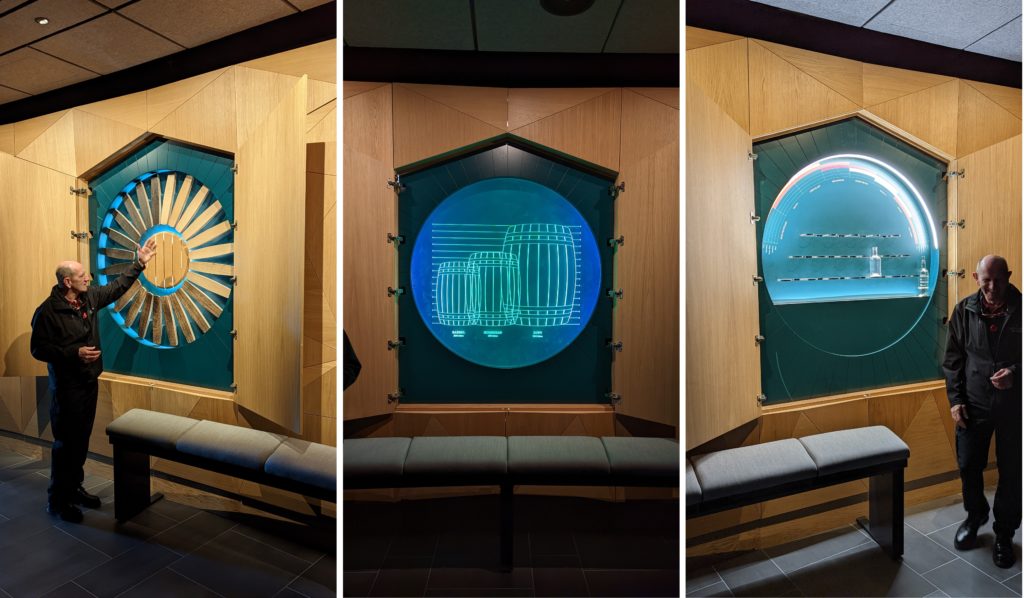
After the stillroom, there’s a nice little display area with three images. The first demonstrates levels of barrel toasting.
Toasting vs charring:
- Toasting: 15-45 mins at 100C
- Charring: 15-45 secs at 250C
The second is a graphic showing different barrel sizes, which is a nice visual reference for folks trying to get their head arounds barrels, butts, and hogsheads.
The third is an infographic that will show different maturation and cask influences.. as soon as they have actual stock at the various levels that they can use to show this.
Dave also mentioned one of the big differences in American versus European Oaks, which I thought I’d pass along:
- American Oak grows faster, has a looser grain, so matures spirit faster.
- European Oak grows slower, has a tighter grain, so matures spirit slower.
OK, so the tour is done, time for a dram. But wait! Their first spriit was only put in a cask in August 2022, and they don’t plan to release until it’s aged 12 years (2034, for the record). So what the hell are we tasting? You’re gonna love this…
G&M know how they want their whisky to taste. The whole distillery is built to produce the NMS they’ll need to get that. And remember, we’re on generation four of the family who spearheaded single malt whisky, with a specialization on selecting and maturing NMS from over 100 distilleries across Scotland. They know what they’re doing. And the thing that they’re doing is gonna take time. They have plans for 12, 18, 25, 30, 57, and 70 year spirits. Don’t do the math, it’s depressing.

To sell this now, however, a group of experts (rumor has it up to 12 people, including the Urquharts) has drawn from G&M’s extensive inventory to produce blends that they believe represent the whisky they’ll start releasing in 2034, 2040, etc. (Sorry, stopping there because I realised I was doing the depressing math for you). The branding on these blends is CRN 12 Year, etc. CRN as an abbreviation of Cairn, because this is /not/ the Cairn whisky. So that’s what we tasted: the CRN 12, 18, and (for our tour) the 25.
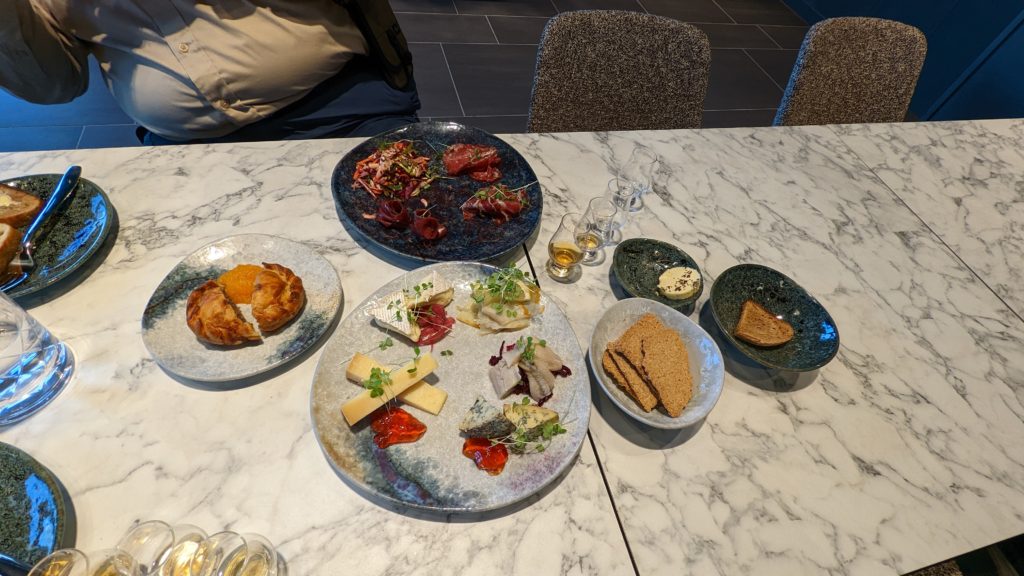
Believe it or not, while the drams were great – really great – they weren’t the best part. The Adventurer’s Tour included a visit to “The Gathering bistro to enjoy tapas, influenced by the flavours of the whisky and shaped by quality ingredients from the local area”. Ohdeargods. Choice of 5 dishes from the menu, or their platter which featured a selection. We were recommended the platter. Which turned out to include damned near everything. It was like being waited on as royalty. Mutton pie, smoked veal prosciutto, veal salami, aged cheese, blue cheese, soft cheese, smoked fish, pickled fish, seasoned butter, fresh baked oatcakes, oh and incredible bread. We didn’t rush, but we also realised that we were the last in the place. Nobody was even close to rushing us out, and in fact seemed to enjoy how much we were enjoying and appreciating the incredible food (and treatment). Turns out that, yeah, we closed the place down. We closed the distillery. I’ve done that with pubs and restaurants, but this is is my first distillery.
And then on to the Highlander Inn in Craigellachie. Neat little Inn with a good whisky menu full of obscure things, but not as obscure as when we were last there in 2019. Oh well. Still found a couple of drams to round out the day.
Another almost overwhelming day. A great tour at a more traditional Ben Nevis, and a very welcoming tour at the brandest of brand new distilleries whose whiskies are intended to age beyond our lifetimes. Holee shit, this stuff is wild.
